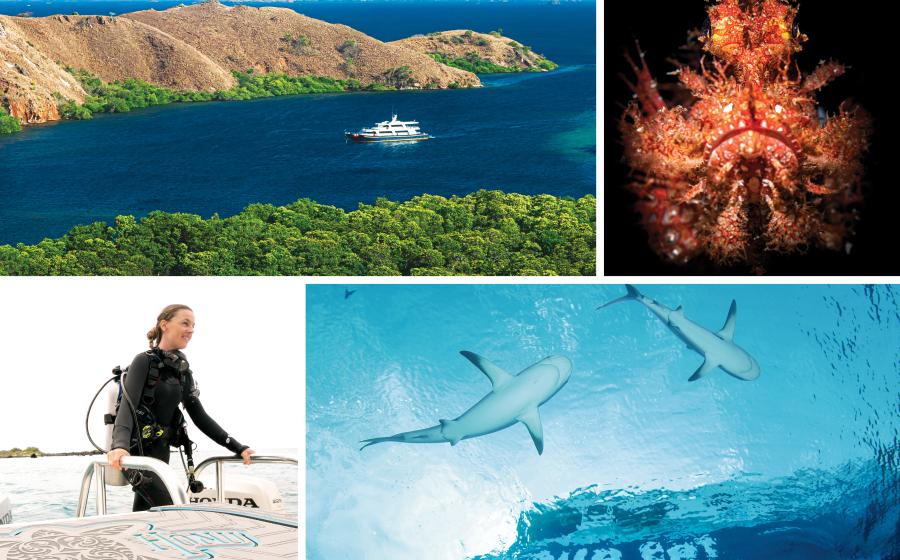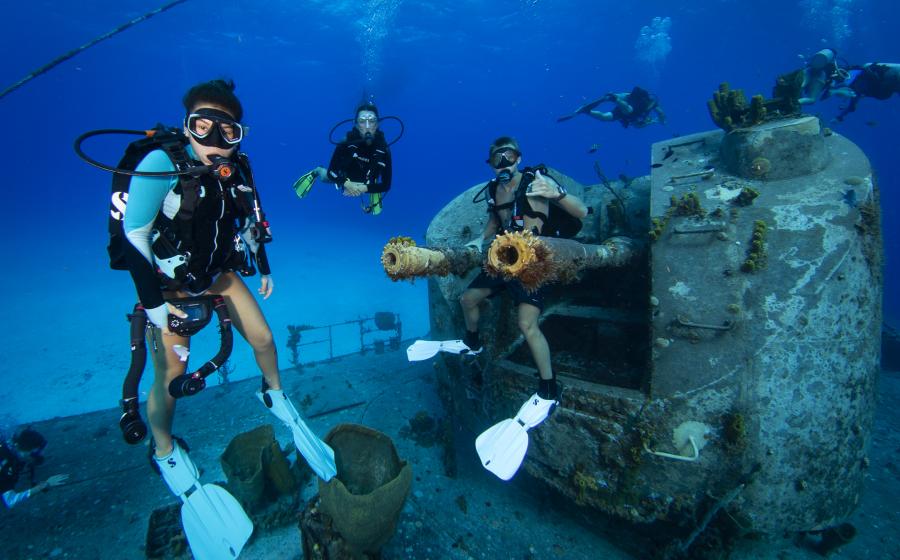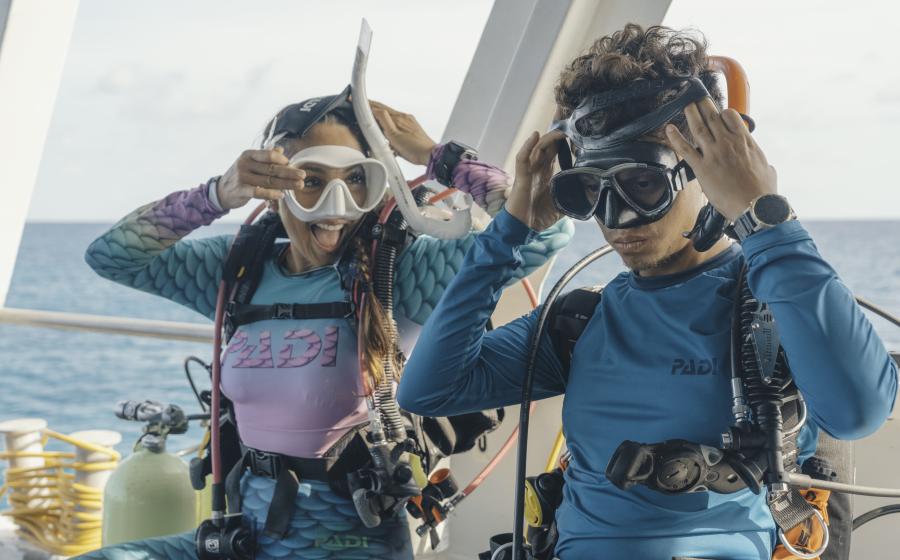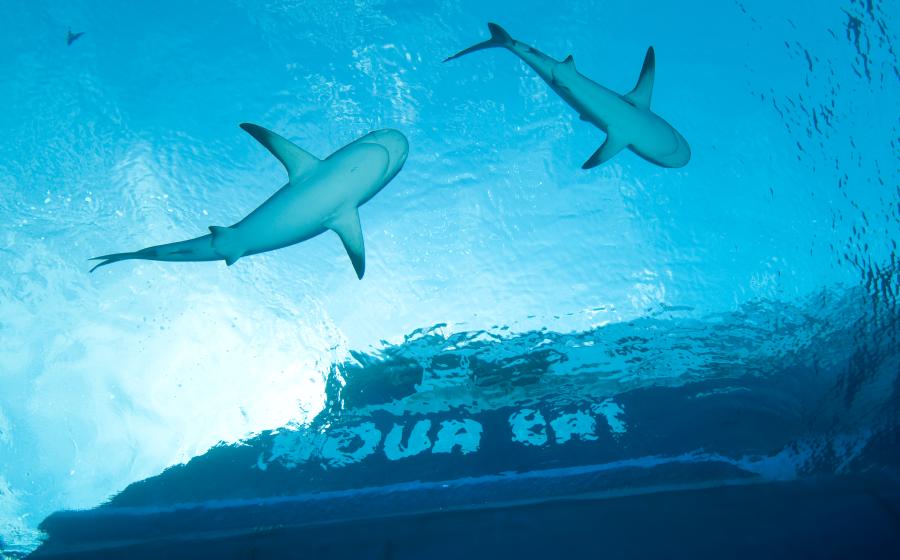Flying After Diving: Latest Research
July 2000
By Ernest Campbell
Flying After Diving: Remember the Rules
Ed.'s note: Answers to questions are offered as information only and not as medical diagnosis or advice and should always be used in conjunction with advice from your personal diving physician.
A few years ago, I took a dive trip to South Bimini. We dived on Friday, Saturday and Sunday morning (70-foot dive, then a 40-foot dive each day). Sunday afternoon, about three to four hours after we surfaced from the last dive, we took a charter flight back to Fort Lauderdale. The pilot asked us if we had dived that day and then wanted to know our profile. He said that he would "keep the ceiling below 1,200." When I mentioned this to a friend recently, she wondered why we didn't get bent. At the time of the flight, I assumed that we were safe. The plane was a small twin-engine Cessna, holding about 12 passengers. Were we in danger of getting bent?
via e-mail
Your pilot was probably correct in that your diving pattern had been relatively safe from the point of view of onloading nitrogen before the flight. We get bubbles when we:
-
Ascend to the surface after a dive.
-
Ascend to altitude after a dive (a continuance of the dive while flying).
-
Ascend to a high altitude from the surface without pressurization.
Therefore, we need to allow a longer time to offgas nitrogen after diving (the same reason we spend a designated time on the surface between dives).
To answer your friend's question, you didn't get bent because you didn't have very much nitrogen in your system and you didn't fly high enough for what you did have to come out of solution as bubbles.
In two of his books on diving, Bruce Wienke says that we "should not worry too much about ascending to altitudes below 3,000 feet as far as sea level diving is concerned--corrections to ordinary protocols are minimal."
The most recent guidelines concerning flying after diving are:
-
A minimum surface interval of 12 hours is required before ascent in a commercial aircraft.
-
Wait an extended surface interval beyond 12 hours after daily, multiple dives for several days or dives that require decompression stops.
-
The deeper or longer the diving, the longer the duration recommended before flying.
These guidelines are for recreational diving and should not apply to commercial diving or nitrox diving. Because of the complex nature of decompression illness and because decompression schedules are based on unverifiable assumptions, there can never be a fixed flying-after-diving rule that can guarantee prevention of bends completely.
DAN is in the midst of a study concerning flying after diving. All reported cases of DCS after a single no-decompression dive have occurred when the pre-flight surface interval was 12 hours or less. After a repetitive dive, DCS occurred even at pre-flight surface intervals as long as 17 hours. The data so far suggest that the original recommendation of waiting 12 hours or more after making single no-decompression dives is reasonable. In addition, current research suggests that it may be wise to wait 17 hours or more after making repetitive dives. However, the research is as yet incomplete and further work is continuing.
Can Diving Cause Dental Problems?
I dived for the first time this past winter (seven dives in two-and-a-half days) and since then I've needed a lot of dental work done. Do you think there's any connection?
via e-mail
Your problem could definitely be related to diving. First, you may have already had dental work that was either loose or in need of repair. If there were any air pockets between your fillings and the tooth surface, then diving would definitely have caused some changes. The trapped air would change in volume as you descended and ascended in the water column, further loosening your repair work.
Second, you could be using a poorly fitting regulator mouthpiece, causing the repair work to loosen. By the same token, you might have clamped your mouthpiece too tightly, causing some tooth damage.
For more information: www.scuba-doc.com/dentprbs.html.
My Ulcer Has Flared Up--Can I Dive?
I was diagnosed with an ulcer that has flared up to the point where I have been put on Prilosec and another stomach medication. Can I go diving? What are the risks?
via e-mail
Diving with an active ulcer is not recommended due to the increased possibility of stress and possible perforation. Perforation or other complications of ulcer (e.g., hemorrhage) would be especially disastrous if they were to occur in an area far from medical care.
If your ulcer heals before your departure date, confer with your doctor about continuation of medication during your trip. Diving per se has no direct effect on the ulcer, one way or the other.
For more information: www.scuba-doc.com/hrtbrn.htm.
Is It OK to Free Dive After a Scuba Dive?
**During my instructor development course, I learned of a change to the PADI open-water training dive sequence: The optional open-water skin dive is now done after the last two open-water training dives.
I thought free dives after scuba diving should be avoided because residual nitrogen in the tissues could be forced back into solution and become hazardous during the speedy ascent associated with free diving.
If PADI has made a change to its training, has there also been a change in the school of thought about free diving after scuba?**
via e-mail
Important clarification: PADI does not specify that the optional open-water skin dive be done after the last open-water training dive. According to Brad Smith, PADI's manager of training and quality management, PADI recommends only that it's an optional skin dive, conducted at the instructor's discretion.
As fas as your concerns about free diving after scuba diving, decompression illness from breath-hold diving does occur. Of particular relevance to the sport diver is what happens to the snorkeling breath-hold diver who repeatedly dives during the surface interval between scuba dives. Very little nitrogen is transferred from the alveoli to the blood during one breath-hold dive. However, repeated dives alter the off-gassing process, cause on-gassing and could completely change subsequent dive profiles. If you go snorkeling between scuba dives, you should stay on the surface.
Can I Use My Asthma Inhalator Before I Dive?
Is it better to use an asthma inhalator before diving or not use it at all? I read that asthma sprays can cause air bubbles to go from veins to the arteries and could cause embolisms.
via e-mail
Asthma sprays do not cause air to move from the veins into the arterial circulation. And, in fact, sprays would be beneficial in opening up any blockage of the airways and in the process would decrease your chances of having pulmonary barotrauma and gas embolism (air into the arterial circulation).
Does Scoliosis Affect My Ability to Dive?
What can you tell me about scoliosis and how it may affect diving?
via e-mail
Probably the main concern with diving with scoliosis is the possibility of decreased pulmonary function. Scoliosis varies considerably in the extent of the curvature. Some cases are so severe that the chest cavity is distorted and the affected person can have abnormal lung function. This would need to be assessed carefully to be sure that you don't have any airway obstruction that could possibly lead to barotrauma or a "burst lung."
Another concern would be possible injury to the spine from lifting heavy weights and tanks. Proper gear fit, degree of physical capacity and cardiac reserve (the ability of the heart to handle stressful situations) might also play a part in your decision to dive.
You will likely have more difficulty with gearing up, entries and exits, but this difficulty disappears in the relatively gravity-free environment of the sea. The advice of your personal physician should be sought with these factors in mind.
Ernest S. Campbell, M.D., FACS, makes his home in Orange Beach, Ala. He is a retired surgeon, avid diver and webmaster of "Diving Medicine Online" (www.scuba-doc.com).
Please send your dive medicine questions to RSD, 6600 Abercorn St., Suite 208, Savannah, GA 31405. Fax: (912) 351-0735. E-mail: edit@scubadiving.com.
July 2000
By Ernest Campbell
Flying After Diving: Remember the Rules
Ed.'s note: Answers to questions are offered as information only and not as medical diagnosis or advice and should always be used in conjunction with advice from your personal diving physician.
A few years ago, I took a dive trip to South Bimini. We dived on Friday, Saturday and Sunday morning (70-foot dive, then a 40-foot dive each day). Sunday afternoon, about three to four hours after we surfaced from the last dive, we took a charter flight back to Fort Lauderdale. The pilot asked us if we had dived that day and then wanted to know our profile. He said that he would "keep the ceiling below 1,200." When I mentioned this to a friend recently, she wondered why we didn't get bent. At the time of the flight, I assumed that we were safe. The plane was a small twin-engine Cessna, holding about 12 passengers. Were we in danger of getting bent?
via e-mail
Your pilot was probably correct in that your diving pattern had been relatively safe from the point of view of onloading nitrogen before the flight. We get bubbles when we:
Ascend to the surface after a dive.
Ascend to altitude after a dive (a continuance of the dive while flying).
Ascend to a high altitude from the surface without pressurization.
Therefore, we need to allow a longer time to offgas nitrogen after diving (the same reason we spend a designated time on the surface between dives).
To answer your friend's question, you didn't get bent because you didn't have very much nitrogen in your system and you didn't fly high enough for what you did have to come out of solution as bubbles.
In two of his books on diving, Bruce Wienke says that we "should not worry too much about ascending to altitudes below 3,000 feet as far as sea level diving is concerned--corrections to ordinary protocols are minimal."
The most recent guidelines concerning flying after diving are:
A minimum surface interval of 12 hours is required before ascent in a commercial aircraft.
Wait an extended surface interval beyond 12 hours after daily, multiple dives for several days or dives that require decompression stops.
The deeper or longer the diving, the longer the duration recommended before flying.
These guidelines are for recreational diving and should not apply to commercial diving or nitrox diving. Because of the complex nature of decompression illness and because decompression schedules are based on unverifiable assumptions, there can never be a fixed flying-after-diving rule that can guarantee prevention of bends completely.
DAN is in the midst of a study concerning flying after diving. All reported cases of DCS after a single no-decompression dive have occurred when the pre-flight surface interval was 12 hours or less. After a repetitive dive, DCS occurred even at pre-flight surface intervals as long as 17 hours. The data so far suggest that the original recommendation of waiting 12 hours or more after making single no-decompression dives is reasonable. In addition, current research suggests that it may be wise to wait 17 hours or more after making repetitive dives. However, the research is as yet incomplete and further work is continuing.
Can Diving Cause Dental Problems?
I dived for the first time this past winter (seven dives in two-and-a-half days) and since then I've needed a lot of dental work done. Do you think there's any connection?
via e-mail
Your problem could definitely be related to diving. First, you may have already had dental work that was either loose or in need of repair. If there were any air pockets between your fillings and the tooth surface, then diving would definitely have caused some changes. The trapped air would change in volume as you descended and ascended in the water column, further loosening your repair work.
Second, you could be using a poorly fitting regulator mouthpiece, causing the repair work to loosen. By the same token, you might have clamped your mouthpiece too tightly, causing some tooth damage.
For more information: www.scuba-doc.com/dentprbs.html.
My Ulcer Has Flared Up--Can I Dive?
I was diagnosed with an ulcer that has flared up to the point where I have been put on Prilosec and another stomach medication. Can I go diving? What are the risks?
via e-mail
Diving with an active ulcer is not recommended due to the increased possibility of stress and possible perforation. Perforation or other complications of ulcer (e.g., hemorrhage) would be especially disastrous if they were to occur in an area far from medical care.
If your ulcer heals before your departure date, confer with your doctor about continuation of medication during your trip. Diving per se has no direct effect on the ulcer, one way or the other.
For more information: www.scuba-doc.com/hrtbrn.htm.
Is It OK to Free Dive After a Scuba Dive?
**During my instructor development course, I learned of a change to the PADI open-water training dive sequence: The optional open-water skin dive is now done after the last two open-water training dives.
I thought free dives after scuba diving should be avoided because residual nitrogen in the tissues could be forced back into solution and become hazardous during the speedy ascent associated with free diving.
If PADI has made a change to its training, has there also been a change in the school of thought about free diving after scuba?**
via e-mail
Important clarification: PADI does not specify that the optional open-water skin dive be done after the last open-water training dive. According to Brad Smith, PADI's manager of training and quality management, PADI recommends only that it's an optional skin dive, conducted at the instructor's discretion.
As fas as your concerns about free diving after scuba diving, decompression illness from breath-hold diving does occur. Of particular relevance to the sport diver is what happens to the snorkeling breath-hold diver who repeatedly dives during the surface interval between scuba dives. Very little nitrogen is transferred from the alveoli to the blood during one breath-hold dive. However, repeated dives alter the off-gassing process, cause on-gassing and could completely change subsequent dive profiles. If you go snorkeling between scuba dives, you should stay on the surface.
Can I Use My Asthma Inhalator Before I Dive?
Is it better to use an asthma inhalator before diving or not use it at all? I read that asthma sprays can cause air bubbles to go from veins to the arteries and could cause embolisms.
via e-mail
Asthma sprays do not cause air to move from the veins into the arterial circulation. And, in fact, sprays would be beneficial in opening up any blockage of the airways and in the process would decrease your chances of having pulmonary barotrauma and gas embolism (air into the arterial circulation).
Does Scoliosis Affect My Ability to Dive?
What can you tell me about scoliosis and how it may affect diving?
via e-mail
Probably the main concern with diving with scoliosis is the possibility of decreased pulmonary function. Scoliosis varies considerably in the extent of the curvature. Some cases are so severe that the chest cavity is distorted and the affected person can have abnormal lung function. This would need to be assessed carefully to be sure that you don't have any airway obstruction that could possibly lead to barotrauma or a "burst lung."
Another concern would be possible injury to the spine from lifting heavy weights and tanks. Proper gear fit, degree of physical capacity and cardiac reserve (the ability of the heart to handle stressful situations) might also play a part in your decision to dive.
You will likely have more difficulty with gearing up, entries and exits, but this difficulty disappears in the relatively gravity-free environment of the sea. The advice of your personal physician should be sought with these factors in mind.
Ernest S. Campbell, M.D., FACS, makes his home in Orange Beach, Ala. He is a retired surgeon, avid diver and webmaster of "Diving Medicine Online" (www.scuba-doc.com).
Please send your dive medicine questions to RSD, 6600 Abercorn St., Suite 208, Savannah, GA 31405. Fax: (912) 351-0735. E-mail: edit@scubadiving.com.






